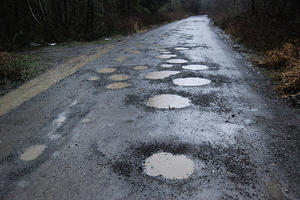InfrastructureBoston has new pot-hole weapons
In a typical year, the city of Boston fills about 19,000 potholes; the city now has two new pot-hole weapons in its arsenal: a $151,300 Pro-Patch Pothole Patcher truck, and a new iPhone and Android app, called Street Bump, which would automatically report potholes to the city by sensing when a car has hit a bump (the app has not been released yet, but test-drives are already being conducted)

The driver's bane faces new weapons // Source: flickr.com
In a typical year, the city of Boston fills about 19,000 potholes, with much of that work coming in the late winter and spring, when freeze-thaw cycles wreak havoc on pavement. Many of the repairs are only temporary patches, in response to road surfaces that are chewing up automobile tires and axles.
Convinced that there should be a better way, city officials are working on a couple of solutions to help them identify potholes earlier and fix them more efficiently. Last week, the Department of Public Works announced it will deploy a new truck, known as the Pro-Patch Pothole Patcher and purchased for $151,300, that is supposed to allow crews to fix potholes in a faster, more permanent fashion.
The Boston Globe reports that meanwhile, Mayor Thomas M. Menino’s Office of New Urban Mechanics, the team that launched the Citizens Connect iPhone app in 2009, is working on an application for smartphones that would automatically report potholes without the need for a driver to dial a number or send a text message.
Currently, most potholes are identified by DPW repair crews dispatched to drive until they find them, Boston Public Works Commissioner Joanne Massaro said. Roughly one in every six potholes that the city fills is reported by the public, via an e-mail, a call to City Hall, or a report made on Citizens Connect, which allows smartphone users to send the city pictures, descriptions, and locations of problems such as graffiti, potholes, and faded crosswalks.
A new app, called Street Bump, would automatically report potholes to the city by sensing when a car has hit a bump. The app, in development, would be sensitive enough to identify cracks and divots, alerting the city to pavement problems before they become car-crunching craters.
The application relies on two components embedded in iPhones, Android phones, and many other mobile devices: the accelerometer and the Global Positioning System receiver. The accelerometer, which determines the direction and acceleration of a phone’s movement, can be harnessed to identify when a phone resting on a dashboard or in a cup holder in a moving car has hit a bump; the GPS receiver can determine by satellite just where that bump is located.
“We’re constantly looking for new ways to make sure that roads are as smooth as they possibly can be, and we believe that Street Bump is a first-in-the nation app,’’ said Chris Osgood, one half of the two-man Urban Mechanics office.
Osgood and Nigel Jacob, his New Urban Mechanics cochairman, have developed the prototype with Fabio Carrera, a professor at Worcester Polytechnic Institute, and Joshua Thorp and Stephen Guerin, developers from the Santa Fe Complex, a civic-minded technology and design think tank in New Mexico.
“It’s a new kind of volunteerism,’’ Jacob said. “It’s not volunteering your sweat equity. It’s volunteering the devices that are in your pocket to help the city.’’ He spoke just as Menino came through the door of a fifth-floor conference room.
“I want this app on my car,’’ Menino said, leaning on crutches as he recovers from surgery to repair a partially torn tendon in his right leg. “I want to find all these potholes and identify [which ones are] city, state, federal.’’
The Globe notes that the prototype is not quite ready for that yet, but on a test drive yesterday afternoon, as a Ford Taurus stamped with the mayoral seal circled the Boston Common, Jacob’s and Osgood’s phones beeped, real time graphs on the displays dancing, every time the car was jostled. Intensive testing this spring and summer should help calibrate the application to weed out noise — sewer grates, elevated crosswalks, and the like — and identify only potholes.
Soon the developers plan to launch a challenge through InnoCentive.com, opening the application to thousands of testers and offering a $25,000 prize, funded by Liberty Mutual, to the programmers who come up with the best ways to improve it.
The more immediate improvement to the city’s pothole patching efforts, the Pro-Patch truck, should allow use of hot asphalt year-round, normally only possible in warmer weather. The truck arrived last fall but has been used only sporadically since.
State officials are also increasingly focused on pothole repair after the series of snowstorms since Christmas. The Department of Transportation spends about $2 million a year on patching potholes.
“The highways really take a beating at this time of year,’’ said Luisa Paiewonsky, the state’s highway administrator. “We have crews out every day filling potholes… . It’s a battle worth fighting, but it is a battle.’’
